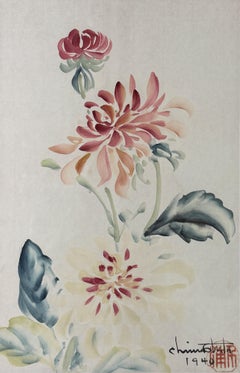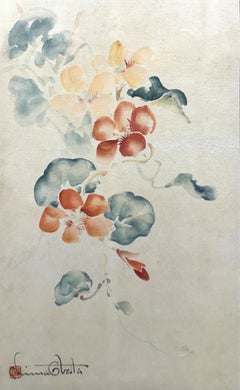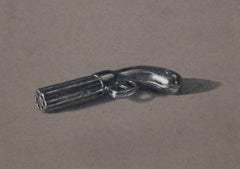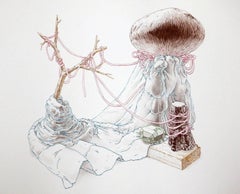Chiura Obata Art
Japanese, 1885-1975
Chiura Obata ranks among the most significant California-based artists and Japanese American cultural leaders of the last century. Born in Okayama, Japan, Obata immigrated to San Francisco in 1903. By then, he was integrating Western practices into his art-making, and continued experimenting with new styles and methods throughout his seven-decade career. Today Obata is best known for majestic views of the American West, sketches based on hiking trips to capture what he called “Great Nature.”
In 1903, Obata moved to San Francisco and began working as an illustrator for The New World and The Japanese American, two of the city's Japanese newspapers. He also did work as a commercial designer. Obata helped establish the East West Art Society in San Francisco in 1921, which sought to promote cross-cultural understanding through art. This goal was reflected in his embrace of the Nihonga style, which fused traditional Japanese sumi-e ink painting with the conventions of western naturalism.
He spent much of the 1920s painting landscapes throughout California, and among his favorite subjects were mountain landscapes. In 1927, he visited Yosemite and the Sierra Nevada, creating over a hundred paintings and sketches of the high country. Obata stayed in the USA until the death of his father in 1928.
In 1932 Obata Chiura returned to the U.S., and began work as an art instructor at the University of California, Berkeley. In April, 1942, Obata Chiura and his wife Haruko were among the more than 100,000 Japanese Americans who were moved from their homes along the West coast into ten relocation camps. He was first sent to Tanforan. In September, 1942, he was moved to the Topaz, Utah, internment camp. During his internment in different camps, the artist made about hundred sketches and paintings until his release in 1945. While confined at Topaz, he organized and acted as Director for the Topaz Art School for the 8,000 Japanese Americans in the camp. Obata's artwork from this time serves as a visual diary of the internees' daily life, and also as a powerful and lasting testament to the perseverance of the human spirit when confronted by prejudice.
In 1943, he was released from Topaz, and moved with his family to St. Louis, where he found work with a commercial art company. When the military exclusion ban was lifted in 1945, he was reinstated to his position at the University of California, where he stayed until his retirement in 1954. Obata was a popular professor, and played a pivotal role in introducing Japanese art techniques and aesthetics that became one of the distinctive characteristics of the California Watercolor School.
After his retirement he continued to paint, sketch and travel through the American countryside. In 1965 he received an order from the Japanese Emperor for promoting cultural exchange between the United States and Japan. A retrospective of his work was organized by the Smithsonian American Art Museum in 2019-2020.to
2
2
2
2
"Dahlias" Chiura Obata, Japanese American, Red and Blue Delicate Floral Work
By Chiura Obata
Located in New York, NY
Chiura Obata
Dahlias, 1940
Signed, dated and stamped lower right
Watercolor on paper
15 x 9 5/8 inches
Born in the Okayama prefecture of Japan, Chiura Obata was adopted by his uncle, an artist. As a child he was trained in ink painting, and at 14 he was apprenticed to the painter Murata Tanryo in Tokyo. He also studied with Kogyo Terasaki and Goho Hasimoto.
In 1903, Obata moved to San Francisco and began working as an illustrator for The New World and The Japanese American, two of the city's Japanese newspapers. He also did work as a commercial designer. Obata helped establish the East West Art Society in San Francisco in 1921, which sought to promote cross-cultural understanding through art. This goal was reflected in his embrace of the Nihonga style, which fused traditional Japanese sumi-e ink painting with the conventions of western naturalism.
He spent much of the 1920s painting landscapes throughout California, and among his favorite subjects were mountain landscapes. In 1927, he visited Yosemite and the Sierra Nevada, creating over a hundred paintings and sketches of the high country. Obata stayed in the USA until the death of his father in 1928.
Between 1928 and 1932, he worked in Tokyo as a painter and transformed his California landscape watercolors...
Category
1940s Modern Chiura Obata Art
Materials
Paper, Watercolor
"Nasturtiums" Chiura Obata, Japanese American, Red and Blue Delicate Flowers
By Chiura Obata
Located in New York, NY
Chiura Obata
Nasturtiums, circa 1940
Signed and stamped lower left
Watercolor on paper
15 x 9 5/8 inches
Born in the Okayama prefecture of Japan, Chiura Obata was adopted by his uncle, an artist. As a child he was trained in ink painting, and at 14 he was apprenticed to the painter Murata Tanryo in Tokyo. He also studied with Kogyo Terasaki and Goho Hasimoto.
In 1903, Obata moved to San Francisco and began working as an illustrator for The New World and The Japanese American, two of the city's Japanese newspapers. He also did work as a commercial designer. Obata helped establish the East West Art Society in San Francisco in 1921, which sought to promote cross-cultural understanding through art. This goal was reflected in his embrace of the Nihonga style, which fused traditional Japanese sumi-e ink painting with the conventions of western naturalism.
He spent much of the 1920s painting landscapes throughout California, and among his favorite subjects were mountain landscapes. In 1927, he visited Yosemite and the Sierra Nevada, creating over a hundred paintings and sketches of the high country. Obata stayed in the USA until the death of his father in 1928.
Between 1928 and 1932, he worked in Tokyo as a painter and transformed his California landscape watercolors...
Category
1940s Modern Chiura Obata Art
Materials
Paper, Watercolor
Related Items
Gun from Clue
By A.J. Fries
Located in Buffalo, NY
An original mixed media drawing by American artist A.J. Fries.
Category
21st Century and Contemporary Realist Chiura Obata Art
Materials
Gouache, Graphite, Paper
"Some far away speech" Still life, Ink and watercolor
By Brian Spolans
Located in Philadelphia, PA
"Some far away speech" is an original ink and watercolor work on paper by Brian Spolans. The piece ships framed as pictured and measures 20.5in x 28.5in. Alternative custom framing...
Category
2010s Contemporary Chiura Obata Art
Materials
Watercolor, Ink, Archival Paper
Rick Owens Hollywood show. From the Fashion series
By Manuel Santelices
Located in Miami Beach, FL
The artist has covered New York collections for over 16 years and has interviewed, as a journalist, several fashion designers and personalities for different publications. He loves t...
Category
21st Century and Contemporary Contemporary Chiura Obata Art
Materials
Paper, Pencil, Gouache
$650
H 15 in W 11 in D 0.1 in
Summer party at the Hoyt House. From the Art, culture & society series
By Manuel Santelices
Located in Miami Beach, FL
Movies, TV and magazines are constant source of inspiration. Fame, as fleckring and shallow it can be sometimes, is very intriguing to him.
The worlds of fashion, society and pop cu...
Category
21st Century and Contemporary Contemporary Chiura Obata Art
Materials
Paper, Ink, Watercolor
$550
H 12 in W 9 in D 0.1 in
Ink and wash cartouche with a mirror, doves, and a drum
Located in Middletown, NY
A lovely and curious composition, circa 1780.
Ink and wash on tissue thin Japon paper, adhered to period cream laid paper, 5 1/4 x 3 3/8 inches (132 x 84 mm), the full sheet. With ...
Category
Late 18th Century French School Chiura Obata Art
Materials
Ink, Handmade Paper, Watercolor
Kutschen (carriages); Group of four designs for hansom cabs.
By Alfred Juergens
Located in Middletown, NY
Four pencil drawings, each with hand coloring in watercolor, each 6 3/4 x 10 inches (sheet) (172 x 254 mm), full margins. Each with inscriptions and notations by the artist in the up...
Category
Mid-20th Century American Modern Chiura Obata Art
Materials
Handmade Paper, Watercolor, Pencil
$800
H 6.78 in W 10.01 in
"Foxglove" (2024) By Ania Mohrbacher, Original Fantasy Watercolor Painting
Located in Denver, CO
"Foxglove" (2024) Is an original watercolor fantasy painting, which depicts a young witch and her black cat in the center of a clearing in a forest, rife with magical flora and fauna...
Category
2010s Surrealist Chiura Obata Art
Materials
Watercolor, Archival Paper
$850
H 14 in W 11 in D 1 in
Gucci Spring 19 Accessories. Fashion watercolor on paper
By Manuel Santelices
Located in Miami Beach, FL
The artist has covered New York collections for over 16 years and has interviewed, as a journalist, several fashion designers and personalities for different publications. He loves t...
Category
21st Century and Contemporary Contemporary Chiura Obata Art
Materials
Paper, Ink, Watercolor
$700
H 12 in W 9 in D 0.1 in
Flowers - Drawing by Albert Fernand-Renault - 1950s
By Albert Fernand-Renault
Located in Roma, IT
Flowers is a drawing realized in 1950s by Albert Fernand-Renault.
Watercolour and ink on paper. Hand-signed.
Good condition with diffused foxing and a cutting at the top left margi...
Category
1950s Modern Chiura Obata Art
Materials
Ink, Watercolor
$497
H 17.72 in W 11.82 in D 0.04 in
"POOR ME", watercolor, hand, bubble wrap, safety, protection, isolated, virus
By Fleur Thesmar
Located in Toronto, Ontario
POOR ME is a small watercolor on Arches paper by Fleur Thesmar. The artwork measures 7x5". Matted and framed in gold, it measures 13x11". Though completed over a year ago, it's a tim...
Category
21st Century and Contemporary Contemporary Chiura Obata Art
Materials
Watercolor, Archival Paper
All about Eve. From the Art, culture & society series
By Manuel Santelices
Located in Miami Beach, FL
Movies, TV and magazines are constant source of inspiration. Fame, as fleckring and shallow it can be sometimes, is very intriguing to him.
The worlds of fashion, society and pop cu...
Category
21st Century and Contemporary Contemporary Chiura Obata Art
Materials
Paper, Watercolor, Gouache
$1,500
H 18 in W 24 in D 0.1 in
Flowers - Watercolor - 1970s
Located in Roma, IT
Flowers is an Original Watercolour realized by an unknown artist in 1970s.
Good condition, included a cream colored cardboard passpartout (42x32.3 cm).
Signature on the lower left ...
Category
1970s Modern Chiura Obata Art
Materials
Watercolor
Previously Available Items
"Jumping Trout, " Chiura Obata, Fish, Japanese-American Artist, Watercolor
By Chiura Obata
Located in New York, NY
Chiura Obata (1885 - 1975)
Leaping Trout, 1930
Watercolor on paper
Sight 23 x 15 inches
Signed and stamped lower left
Provenance:
Private Collection, Massachusetts
Chiura Obata ranks among the most significant California-based artists and Japanese American cultural leaders of the last century. Born in Okayama, Japan, Obata immigrated to San Francisco in 1903. By then, he was integrating Western practices into his art-making, and continued experimenting with new styles and methods throughout his seven-decade career. Today Obata is best known for majestic views of the American West, sketches based on hiking trips to capture what he called “Great Nature.” Every work is grounded in close observation, rendered with calligraphic brushstrokes and washes of color.
Born in the Okayama prefecture of Japan, Chiura Obata was adopted by his uncle, an artist. As a child he was trained in ink painting, and at 14 he was apprenticed to the painter Murata Tanryo in Tokyo. He also studied with Kogyo Terasaki and Goho Hasimoto.
In 1903, Obata moved to San Francisco and began working as an illustrator for The New World and The Japanese American, two of the city's Japanese newspapers. He also did work as a commercial designer. Obata helped establish the East West Art Society in San Francisco in 1921, which sought to promote cross-cultural understanding through art. This goal was reflected in his embrace of the Nihonga style, which fused traditional Japanese sumi-e ink painting with the conventions of western naturalism.
He spent much of the 1920s painting landscapes throughout California, and among his favorite subjects were mountain landscapes. In 1927, he visited Yosemite and the Sierra Nevada, creating over a hundred paintings and sketches of the high country. Obata stayed in the USA until the death of his father in 1928.
Between 1928 and 1932, he worked in Tokyo as a painter and transformed his California landscape watercolors and sketches into a portfolio of 35 woodblock prints titled World Landscape Series - America, perhaps his most famous work. Obata's landscapes reveal his intensely personal and poetic vision of "Great Nature", a vision grounded in an underlying Zen philosophy of selflessness that accepts the insignificance of human affairs in relation to the timeless forces of nature.
In 1932 Obata Chiura returned to the U.S., and began work as an art instructor at the University of California, Berkeley. In April, 1942, Obata Chiura and his wife Haruko were among the more than 100,000 Japanese Americans who were moved from their homes along the West coast into ten relocation camps. He was first sent to Tanforan. In September, 1942, he was moved to the Topaz, Utah, internment camp. During his internment in different camps, the artist made about hundred sketches and paintings until his release in 1945. The book, Topaz Moon, edited by his granddaughter Kimi Kodani Hill, is a documentation of his detention period and the works of art that he created during this time. While confined at Topaz, he organized and acted as Director for the Topaz Art School for the 8,000 Japanese Americans in the camp. The school had 16 artist instructors who taught 23 subjects to over 600 students. Obata's artwork from this time serves as a visual diary of the internees' daily life, and also as a powerful and lasting testament to the perseverance of the human spirit when confronted by prejudice.
In 1943, he was released from Topaz, and moved with his family to St. Louis, where he found work with a commercial art company. When the military exclusion ban was lifted in 1945, he was reinstated to his position at the University of California, where he stayed until his retirement in 1954. Obata was a popular professor, and played a pivotal role in introducing Japanese art techniques and aesthetics that became one of the distinctive characteristics of the California Watercolor School...
Category
1930s American Modern Chiura Obata Art
Materials
Paper, Watercolor
"Yosemite National Park, California Landscape, " Chiura Obata, Japanese-American
By Chiura Obata
Located in New York, NY
Chiura Obata (1885 - 1975)
Yosemite National Park, California Landscape
Watercolor on silk, mounted on paper
Image 45 1/2 x 16 inches
Stamped and signed lower left
Chiura Obata ranks among the most significant California-based artists and Japanese American cultural leaders of the last century. Born in Okayama, Japan, Obata immigrated to San Francisco in 1903. By then, he was integrating Western practices into his art-making, and continued experimenting with new styles and methods throughout his seven-decade career. Today Obata is best known for majestic views of the American West, sketches based on hiking trips to capture what he called “Great Nature.” Every work is grounded in close observation, rendered with calligraphic brushstrokes and washes of color.
Born in the Okayama prefecture of Japan, Chiura Obata was adopted by his uncle, an artist. As a child he was trained in ink painting, and at 14 he was apprenticed to the painter Murata Tanryo in Tokyo. He also studied with Kogyo Terasaki and Goho Hasimoto.
In 1903, Obata moved to San Francisco and began working as an illustrator for The New World and The Japanese American, two of the city's Japanese newspapers. He also did work as a commercial designer. Obata helped establish the East West Art Society in San Francisco in 1921, which sought to promote cross-cultural understanding through art. This goal was reflected in his embrace of the Nihonga style, which fused traditional Japanese sumi-e ink painting with the conventions of western naturalism.
He spent much of the 1920s painting landscapes throughout California, and among his favorite subjects were mountain landscapes. In 1927, he visited Yosemite and the Sierra Nevada, creating over a hundred paintings and sketches of the high country. Obata stayed in the USA until the death of his father in 1928.
Between 1928 and 1932, he worked in Tokyo as a painter and transformed his California landscape watercolors and sketches into a portfolio of 35 woodblock prints titled World Landscape Series - America, perhaps his most famous work. Obata's landscapes reveal his intensely personal and poetic vision of "Great Nature", a vision grounded in an underlying Zen philosophy of selflessness that accepts the insignificance of human affairs in relation to the timeless forces of nature.
In 1932 Obata Chiura returned to the U.S., and began work as an art instructor at the University of California, Berkeley. In April, 1942, Obata Chiura and his wife Haruko were among the more than 100,000 Japanese Americans who were moved from their homes along the West coast into ten relocation camps. He was first sent to Tanforan. In September, 1942, he was moved to the Topaz, Utah, internment camp. During his internment in different camps, the artist made about hundred sketches and paintings until his release in 1945. The book, Topaz Moon, edited by his granddaughter Kimi Kodani Hill, is a documentation of his detention period and the works of art that he created during this time. While confined at Topaz, he organized and acted as Director for the Topaz Art School for the 8,000 Japanese Americans in the camp. The school had 16 artist instructors who taught 23 subjects to over 600 students. Obata's artwork from this time serves as a visual diary of the internees' daily life, and also as a powerful and lasting testament to the perseverance of the human spirit when confronted by prejudice.
In 1943, he was released from Topaz, and moved with his family to St. Louis, where he found work with a commercial art company. When the military exclusion ban was lifted in 1945, he was reinstated to his position at the University of California, where he stayed until his retirement in 1954. Obata was a popular professor, and played a pivotal role in introducing Japanese art techniques and aesthetics that became one of the distinctive characteristics of the California Watercolor School...
Category
Mid-20th Century Chiura Obata Art
Materials
Silk, Watercolor
Ink Painting of two Shorebirds on the Beach
By Chiura Obata
Located in Burbank, CA
Ink painting of two seabirds on the shore. Following his internment during WWII, Obata chose to focus on sumi painting. He had many students over the decades, and one could guess tha...
Category
1930s Showa Chiura Obata Art
Materials
Sumi Ink
Before Singing: Madame Talia Savanieva.
By Chiura Obata
Located in Burbank, CA
Print number 31 from the series of 35; it is the only portrait in the series. Madame Savanieva was an opera diva who sang in San Francisco in the late 1920s. This print reportedly re...
Category
1930s Showa Chiura Obata Art
Materials
Woodcut
Chiura Obata art for sale on 1stDibs.
Find a wide variety of authentic Chiura Obata art available for sale on 1stDibs.




